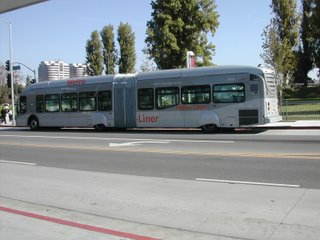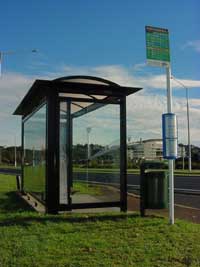Tuesday, July 18, 2006
Busways and Bus Rapid Transport: The International and New Zealand context.
Introductions
Bus rapid transit (BRT) is a broad term given to a variety of different transportation systems involving buses and ranges from:
● Dedicated exclusive busways such
● Buses operating in high occupancy vehicle lanes or in mixed traffic, such as in
● Dedicated busways with some form of guidance such as in
● A mix of initiatives such as signal prioritisation, off-bus fare collection, level boarding upgraded and or well spaced bus stops and real time information services, such as LA’s MetroRapid.
BRT is a fuzzy concept that could broadly be argued is any bus measure above basic normal on-street operation.
This study will be investigating bus measures internationally with a focus on exclusive busways as is proposed for Wellingtons Northern Corridor.
BRT is an old concept and was apparently first proposed in
BRT is often portrayed as “like rail;” or “rubber rail;” however without the cost. Which asks the obvious question – if it’s so much like rail – why not just build rail to start with?
Advantages of BRT
Busways and BRT are perceived to have positive effects on road congestion and are seen to improve this, cheaper than light or heavy rail can. Busways are often cheaper in the short term because of lower vehicle capital costs; they utilise existing streets and road maintenance costs are usually externalised.
Busways are seen as being more flexible and responsive to population changes. They can provide seamless travel, reducing the numbers of transfers, from a distant suburb to the city; with roving buses driving through normal streets picking up passengers until they join the express busway to central destination.
Busways can be built incrementally and extended as desired.
The International situation
Just this week two large bus BRT projects internationally have been turned down in favour of light rail alternatives – In Minneapolis and Seattle.
To start with it is best to look at the home of BRT Los Angeles.
LA’s El Monte busway opened in 1973 and was moderately successful peaking with ridership at 30 000 per day, however opening the busway to high occupancy vehicles (HOV) and resulting congestion resulted in a 33% reduction in passenger
1997-2000 LA opened the Harbour Transitway, an 11km stretch of mixed bus and HOV for approximately $500 million, and whilst there is debate on the passenger figures there is consensus that it is low; below predictions, and substantially less than the near-by LRT.
LA’s Metro Orange Line is a dedicated busway that curiously is classified as a rail network and is given a colour coding. This busway was opened recently and is still under construction. The project has been plagued by work disruptions and the busway has seen numerous crashes both as a result of bus driver error and vehicles ent
ering the busway.
LA’s silver line – a ‘train-like-bus,’ where buses are painted the same colour as the train and are officially part
of the train network.
ies 285 passengers compared to 131 passengers for buses
Prepayment of fares and level boarding, systems typically found in rail systems, create a very efficient boarding and deboarding process. A bi-articulated bus (a 5-door, 82-foot bus built by Volvo and currently used only in
f buses using the busway is 13 miles per hour--twice the estimated speed for buses operating in the same
There are five busways, each between 5 and 7.5 miles long, radiating from the city centre. The most recent busway was completed in 1994 at a cost of $1.5 million per kilometre. There are plans to add circumferential busways to link key suburban areas. Curitiba is a great example of a ‘like rail,’ BRT system with extensive ex
clusive busways, huge buses, more akin to trains; however the buses are considerably overcrowded and affected by increasing road congestion due to increasing affluence and vehicle use, Curitiba is considering other transport modes.
Auckland
In New Zealand we have our very own busway nearing competition (2007); Auckland’s Northern Busway is estimated to cost in total 325.5million and will ccomprise a 6.0 km stretch of dedicated two-way roadway for buses in both directions and HOV lanes, having southbound access only in the morning peak, the planned two-lane busway will run between Constellation Drive and Esmond
e Road. Bus stations will be located at
The busway has encountered controversy over the bus company tender process and has been criticised for not including cycle lanes or a bus lane on the harbour bridge, where congestion is expected to be high.
Depressing photo of what the
Disadvantages of BRT
One bus has space for about 50 passengers only; articulated or double decker buses may push the crush load capacity to about 100. Thus the BRT transport vessel has an intrinsic capacity limitation and finds its place on the capacity scale between standard bus services and rail-based systems. In
BRT is often considered cheaper; and whilst construction and capital costs usually are, operating costs are not necessarily. In Boston operating costs per passenger mile of LRT was 32 percent cheaper than BRT; of rail, 50 percent cheaper (2002), and in LA their LRT was 24 percent cheaper than bus; rail rapid transit 22 percent cheaper.
When a dedicated roadway is only available for part of the bus journey the BRT system is still subject to traffic congestion especially at the entrances, such as in
As with truck traffic, heavy bus traffic with its high axle-load causes significant wear and tear of the road surface, and regular investment is required to maintain quality. This is a particular problem for guided busways, bus stops and similar situations where the wheels always pass exactly over the same spot, whereas rail lines can take considerable wear. A further argument against BRT is that the rolling resistance of rubber wheel on tarmac is many times that between steel wheel and steel rail (a factor of between 5 and 10 is often quoted).
BRT also suffers from images problems associated with buses. Some argue, they do not attract the ridership of rail lines, and it is not clear whether they can encourage secondary advantages such as neighbourhood revitalization and business development. Conversely, some South American systems claim capacity in the order of 40,000 passengers per hour per direction, levels that are consistent with some heavy rail, metro systems. Similarly, many more modest BRT systems may operate with daily ridership that equals or exceeds that of light rail LRT systems in other cities.
Environmentally, the majority of buses internationally are run on diesel and thus contribute to local pollution and climate change. I could not find any busways internationally that utilised trolley buses. Bus exhaust fumes also increase costs, where tunnels are part of the network; requiring large extraction fans to remove diesel particulates.
BRT on the Johnsonville line
Conclusion
BRT and busways are a technology still in its infancy and there are no shinning examples internationally to act as a model for
Your article has been very useful, and I've used it as the basis for a post on my own blog. Your contribution to the debate there would be most welcome!
It's great to see another Wellingtonian joining this debate.
I have to disagree with your conclusion though. I've posted the reasons on my blog:
http://betterbus.blogspot.com/2006/07/rail-neither-popular-nor-affordable.html
I too think the busway is is crasy proposal. Better, Wellington improved it's suburban rail service by elimination of some smaller rail stations in Hutt & Paraparam lines and develope other key stations such as Porirua,for E'G as principal stations with massive bus interchange faccilities that drive up overtop. Shopping facilities could also be provided. Porirua is a prime example for developers.
Also, why not extend the line on a loop through Haywoods to the Hutt Valley. This would give commuters ability to access eith Porirua basin or Hutt Valley without having to go all the damn way back into Wellington to change trains. Would also open up Haywoods area for housing & development. Imagine a two line electric track to & from the Hutt Valley & Kapi Mana.
Carl Pedersen. Melbourne Vict. 17/09/06
Here is another idea NZ'ers cold try. Melbourn has one of the biggest dedicated bicycle trail networks in the world. 100's of klm's of them, as we are mostly flat.
Well, Christchurch is even flatter. Why don't they go back to the way things were in the pre-1950's & embark on a massive construction of dedicated bike paths. complete with grade separation, tunnels etc. Could say much in fuel & decongest inner Ch Ch streets. Ch Ch is so lucky, not like Ak or Wgton in that the latter two are a tad too steep. Get with it Christchurch.
Carl
<< Home






